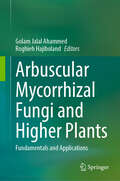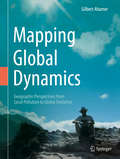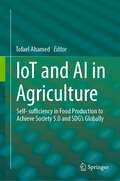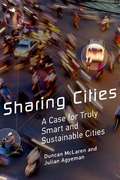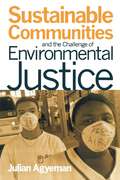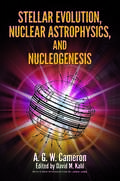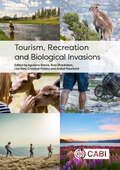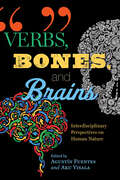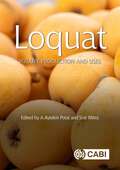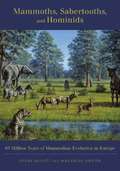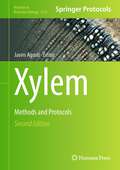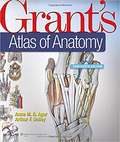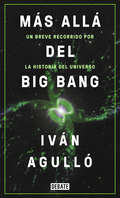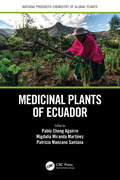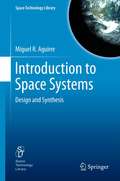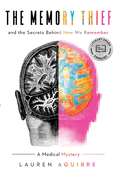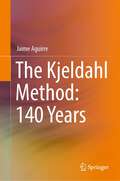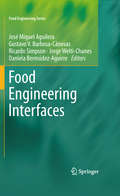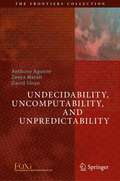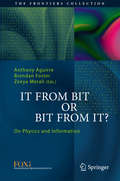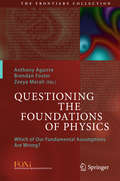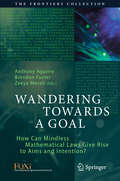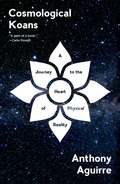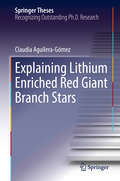- Table View
- List View
Arbuscular Mycorrhizal Fungi and Higher Plants: Fundamentals and Applications
by Golam Jalal Ahammed Roghieh HajibolandThis book covers the fundamentals of arbuscular mycorrhizal fungi (AMF) and higher plant symbiosis with potential implications in crop production. It provides new insights into our understanding of the mechanisms of AMF-mediated plant growth regulation and stress tolerance covering the most recent biochemical, physiological, molecular, environmental, and ecological studies. Focusing on AMF-induced physiological and molecular mechanisms of enhanced tolerance to stress, environmental stress is discussed in several dedicated chapters. The book provides not only updated information with new insights and perspectives but also several new topics, such as a comprehensive discussion on biotic stressors, AMF interaction with other microorganisms, non-host plant species, plant secondary metabolism, signaling events in plant-AMF symbiosis, AMF-mediated nutrient acquisition and subsequent stress tolerance. The book also discusses the potential implications of AMF for sustainable crop production in the context of climate change. The book can be a useful reference book for academics and scientists involved in related research, such as academics in agronomy and plant sciences, scientists involved in beneficial fungi research, chemists, industrialists, and employees involved in the production and marketing of biofertilizers, master and doctoral degree students of agronomy, horticulture, and plant protection, consultants working on the production of crops in marginal environments as well as environmental scientists working for assisted phytoremediation programs. It would also be suitable for agronomy, ecology, and plant science-related courses, such as plant stress physiology, plant growth-promoting microbes, and plant pathology to teach undergraduate, graduate, and postgraduate students at colleges and universities.
Mapping Global Dynamics: Geographic Perspectives from Local Pollution to Global Evolution
by Gilbert AhamerThis book asks: What are the most suitable “mapping strategies” for detecting patterns of global dynamics?It adopts a spatial perspective when trying to understand “Global Dynamics” – and sets out to revolutionise the concept of space as such. Spatial views – on levels of increasing abstraction, reflection and self-organisation – are developed along eight case studies including air emissions, environmental radioactivity, deforestation, energy from biomass, land use change, food supply, water quality and cooperative interdisciplinary learning for global change.This book’s conceptual innovation consists in performing a transformation from “space & time” into “functional state space & evolutionary time” in order to better recognise the structural patterns of long-term global dynamics. A transdisciplinary readership in academia – including geography, philosophy, economics, global change and future research – that is interested in enlarging scientific concepts beyond classical borders – would be most welcome!
IoT and AI in Agriculture: Self- sufficiency in Food Production to Achieve Society 5.0 and SDG's Globally
by Tofael AhamedThis book reviews recent innovations in the smart agriculture space that use the Internet of Things (IoT) and sensing to deliver Artificial Intelligence (AI) solutionsto agricultural productivity in the agricultural production hubs. In this regard, South and Southeast Asia are one of the major agricultural hubs of the world, facing challenges of climate change and feeding the fast-growing population. To address such challenges, a transboundary approach along with AI and BIG data for bioinformatics are required to increase yield and minimize pre- and post-harvest losses in intangible climates to drive the sustainable development goal (SDG) for feeding a major part of the 9 billion population by 2050 (Society 5.0 SDG 1 & 2). Therefore, this book focuses on the solution through smart IoT and AI-based agriculture including pest infestation and minimizing agricultural inputs for in-house and fields production such as light, water, fertilizer and pesticides to ensure food security aligns with environmental sustainability. It provides a sound understanding for creating new knowledge in line with comprehensive research and education orientation on how the deployment of tiny sensors, AI/Machine Learning (ML), controlled UAVs, and IoT setups for sensing, tracking, collection, processing, and storing information over cloud platforms for nurturing and driving the pace of smart agriculture in this current time. The book will appeal to several audiences and the contents are designed for researchers, graduates, and undergraduate students working in any area of machine learning, deep learning in agricultural engineering, smart agriculture, and environmental science disciplines. Utmost care has been taken to present a varied range of resource areas along with immense insights into the impact and scope of IoT, AI and ML in the growth of intelligent digital farming and smart agriculture which will give comprehensive information to the targeted readers.
Sharing Cities: A Case for Truly Smart and Sustainable Cities
by Julian Agyeman Duncan MclarenThe future of humanity is urban, and the nature of urban space enables, and necessitates, sharing -- of resources, goods and services, experiences. Yet traditional forms of sharing have been undermined in modern cities by social fragmentation and commercialization of the public realm. In Sharing Cities, Duncan McLaren and Julian Agyeman argue that the intersection of cities' highly networked physical space with new digital technologies and new mediated forms of sharing offers cities the opportunity to connect smart technology to justice, solidarity, and sustainability. McLaren and Agyeman explore the opportunities and risks for sustainability, solidarity, and justice in the changing nature of sharing. McLaren and Agyeman propose a new "sharing paradigm," which goes beyond the faddish "sharing economy" -- seen in such ventures as Uber and TaskRabbit -- to envision models of sharing that are not always commercial but also communal, encouraging trust and collaboration. Detailed case studies of San Francisco, Seoul, Copenhagen, Medellín, Amsterdam, and Bengaluru (formerly Bangalore) contextualize the authors' discussions of collaborative consumption and production; the shared public realm, both physical and virtual; the design of sharing to enhance equity and justice; and the prospects for scaling up the sharing paradigm though city governance. They show how sharing could shift values and norms, enable civic engagement and political activism, and rebuild a shared urban commons. Their case for sharing and solidarity offers a powerful alternative for urban futures to conventional "race-to-the-bottom" narratives of competition, enclosure, and division.
Sustainable Communities and the Challenge of Environmental Justice
by Julian AgyemanPopularized in the movies Erin Brockovich and A Civil Action, "environmental justice" refers to any local response to a threat against community health. In this book, Julian Agyeman argues that environmental justice and the sustainable communities movement are compatible in practical ways. Yet sustainability, which focuses on meeting our needs today while not compromising the ability of our successors to meet their needs, has not always partnered with the challenges of environmental justice.Sustainable Communities and the Challenge of Environmental Justice explores the ideological differences between these two groups and shows how they can work together. Agyeman provides concrete examples of potential model organizations that employ the types of strategies he advocates. This book is vital to the efforts of community organizers, policymakers, and everyone interested in a better environment and community health.
Stellar Evolution, Nuclear Astrophysics, and Nucleogenesis (Dover Books On Physics Series)
by A.G.W. Cameron David Miles Kahl Jordi Jose"The content of this work, which was independently presented by Burbidge, Burbidge, Fowler, and Hoyle in 1957, represents one of the major advances in the natural sciences in the twentieth century. It effectively answered, in one fell swoop, several interrelated questions that humans have been asking since the beginning of inquiry, such as 'What are stars?' 'How does the sun shine?' 'Why is gold so rare?' 'Where did the elements in our world and in our bodies come from?'" — Alan A. Chen, Associate Professor, McMaster UniversityHarvard professor A. G. W. Cameron — who helped develop the Giant Impact Theory, a revolutionary concept concerning the formation of the moon — originally published this survey in a technical report of Canada's Chalk River Laboratories. Nuclear astrophysics has come of age in the decades since, during which the paper by Burbidge et al. was widely available while Cameron's study remained inaccessible. Long out of print and very hard to find, this remarkable work is now available in an affordable paperback edition for the very first time. Newly edited and retypeset by an expert in atomic physics, it provides a valuable resource to cosmologists, astrophysicists, and graduate students of nuclear astrophysics.
Tourism, Recreation and Biological Invasions
by Agustina Barros, Ross Shackleton, Lisa J. Rew, Cristóbal Pizarro and Aníbal PauchardThe first section of the book includes information about how tourism-related infrastructure and activities promote biological invasions, including key pathways for non-native invasive species introductions. This section provides case studies of different organisms that are known to be introduced and/or promoted by tourism in different ecosystems or regions. The second section elaborates on known and potential impacts of invasive species on tourism and recreation, including how they may affect, positively or negatively, the economic revenue from tourism, tourist access, recreation, aesthetic values and tourists' perceptions. The last section focuses on management and policy, covering aspects of how visitors perceive invasive species and their willingness to manage them, biosecurity measures to prevent invasion related to tourism, as well as potential policy options moving forward. The book draws on a number of examples across multiple taxa, landscapes and regions of the world.
Source Mechanisms of Earthquakes: Theory and Practice
by Agustín Udías Raúl Madariaga Elisa Buforn Agustín Udías Raúl MadariagaThis book presents an innovative new approach to studying source mechanisms of earthquakes, combining theory and observation in a unified methodology, with a key focus on the mechanics governing fault failures. It explains source mechanisms by building from fundamental concepts such as the equations of elasticity theory to more advanced problems including dislocation theory, kinematic models and fracture dynamics. The theory is presented first in student-friendly form using consistent notation throughout, and with full, detailed mathematical derivations that enable students to follow each step. Later chapters explain the widely-used practical modelling methods for source mechanism determination, linking clearly to the theoretical foundations, and highlighting the processing of digital seismological data. Providing a unique balance between application techniques and theory, this is an ideal guide for graduate students and researchers in seismology, tectonophysics, geodynamics and geomechanics, and a valuable practical resource for professionals working in seismic hazard assessment and seismic engineering.
Verbs, Bones, and Brains: Interdisciplinary Perspectives on Human Nature
by Agustín Fuentes and Aku Visala&“A benchmark collection of essays on the contemporary understanding of human nature. . . . [engaging] biology and anthropology to theology and philosophy.&” —Robin W. Lovin, Cary M. Maguire University Professor of Ethics emeritus, Southern Methodist University, author of What Do We Do When No One is Listening: Leading the Church in a Polarized Society The last few decades have seen an unprecedented surge of empirical and philosophical research into the evolutionary history of Homo sapiens, the origins of the mind/brain, and human culture. This research has sparked heated debates about the nature of human beings and how knowledge about humans from the sciences and humanities should be properly understood. The goal of Verbs, Bones, and Brains: Interdisciplinary Perspectives on Human Nature is to engage these themes and present current debates, discussions, and discourse for a range of readers. The contributors bring the discussion to life with key experts outlining major concepts paired with cross-disciplinary commentaries in order to create a novel approach to thinking about, and with, human natures. Throughout, they emphasize the importance of seeking a convergence in our views on human nature, despite metaphysical disagreements. They caution that if convergence eludes us and a common ground cannot be found, this is itself a relevant result: it would reveal to us how deeply our questions about ourselves are connected to our basic metaphysical assumptions. Instead, their focus is on how the interdisciplinary and possibly transdisciplinary conversation can be enhanced in order to identify and develop a common ground on what constitutes human nature. &“A landmark volume. . . . It shows the fruitfulness of a mutually respectful and yet rigorous approach to cross-disciplinary engagement.&” (William Storrar, Center of Theological Inquiry, Princeton, NJ, editor of A World for All?: Global Civil Society in Political Theory and Trinitarian Theology &“Fascinating, well-organized, and well-edited.&” —Choice
Loquat: Botany, Production and Uses (Botany, Production and Uses)
by Manuel Agustí Josep Armengol Maria Luisa Badenes Manuel Blasco Julián Cuevas González Vittorio Farina Elisa González-Dominguez Qigao Guo Liang Guolu Juan José Hueso Yuanyuan Jiang Francisco Legaz Hailan Lin Shoukai Lin Dahe Lin Shunquan Lin Shiwei Ma Belén Martínez-Alcántara Amparo Martínez-Fuentes Carlos Mesejo Julia Morales Ana Quiñones Carmina Reig Esteban Soler Jincheng Wu Bisha Wu Xianghui Yang Peng Ze Lifen ZhangLoquat (Eriobotrya japonica Lindl.) is a subtropical evergreen fruit tree indigenous to China. Records show it has been cultivated in China for over 2000 years. From this beginning, loquat has spread to more than 30 countries around the world. Grown in various regions of Asia, the Mediterranean and across the Americas, loquats suit both temperate and subtropical areas, sharing the same environmental conditions as citrus. Loquat is an increasingly commercial crop in some Asian and European countries with a good amount of international trade. Recent research has focused on improving crop yields and quality. Over 100 different varieties have been developed to meet both growers' and consumers' demands. These developments have contributed to a better understanding of the crop environment, plant growth and physiology of tree and fruit development with implications for both breeding and cultivation. This book is to be the first to provide a comprehensive coverage of the history, physiology, culture and marketing of loquat throughout the world.
Mammoths, Sabertooths, and Hominids: 65 Million Years of Mammalian Evolution in Europe
by Jordi Agustí Mauricio AntónMammoths, Sabertooths, and Hominids takes us on a journey through 65 million years, from the aftermath of the extinction of the dinosaurs to the glacial climax of the Pleistocene epoch; from the rain forests of the Paleocene and the Eocene, with their lemur-like primates, to the harsh landscape of the Pleistocene Steppes, home to the woolly mammoth. It is also a journey through space, following the migrations of mammal species that evolved on other continents and eventually met to compete or coexist in Cenozoic Europe. Finally, it is a journey through the complexity of mammalian evolution, a review of the changes and adaptations that have allowed mammals to flourish and become the dominant land vertebrates on Earth. With the benefit of recent advances in geological and geophysical techniques, Jordi Agustí and Mauricio Antón are able to trace the processes of mammalian evolution as never before; events that hitherto appeared synchronous or at least closely related can now be distinguished on a scale of hundreds or even dozens of thousands of years, revealing the dramatic importance of climactic changes both major and minor. Evolutionary developments are rendered in magnificent illustrations of the many extraordinary species that once inhabited Europe, detailing their osteology, functional anatomy, and inferred patterns of locomotion and behavior. Based on the latest research and field work, Mammoths, Sabertooths, and Hominids transforms our understanding of how mammals evolved and changed the face of the planet.
Xylem: Methods and Protocols (Methods in Molecular Biology #2722)
by Javier AgustiThis second edition provides detailed techniques used for the study and characterization of the plant vascular system, with a central focus on the xylem tissue. Chapters are organized in three main sections covering; analysis of xylem development, xylem characterization though imaging techniques, and analysis of the xylem composition. Written in the highly successful Methods in Molecular Biology series format, chapters include introductions to their respective topics, lists of the necessary materials and reagents, step-by-step, readily reproducible laboratory protocols, and key tips on troubleshooting and avoiding known pitfalls. Authoritative and cutting-edge, Xylem: Methods and Protocols, Second Edition aims to be a useful and practical guide to new researchers and experts looking to expand their knowledge.
Grant's Atlas of Anatomy
by Anne M. R. Agur Arthur F. DalleyA cornerstone of gross anatomy since 1943, Grant's Atlas of Anatomy reaches students worldwide with its realistic dissection illustrations, detailed surface anatomy photos, clinical images and comments, and quick-reference muscle tables. Renowned for its accuracy, pedagogy, and clinical relevance, this classic atlas boasts significant enhancements, including updated artwork, new conceptual diagrams, and vibrantly re-colored illustrations. Clinical material is clearly highlighted in blue text for easy identification.
Más allá del Big Bang: Un breve recorrido por la historia del universo
by Iván AgullóUna provocación al intelecto que nos embarca en un viaje fascinante a través del tejido cósmico. ¿Qué fue el Big Bang realmente? ¿El universo es eterno o tuvo un comienzo? ¿Tendrá un final? El lector tiene entre manos una obra que pone las grandes cuestiones del universo al alcance de todos. Con la capacidad de presentar con sencillez temas tan sumamente complejos como la Teoría de Cuerdas y la Gravedad Cuántica de Lazos, Iván Agulló aporta algo de orden al caos infinito de interrogantes que la cosmología enfrenta en la actualidad. Lo hace mediante esta breve historia del universo y de los brillantes teóricos que han revolucionado por completo los cimientos de la ciencia y de nuestro entendimiento de todo cuanto nos rodea. Con una gran profundidad intelectual y filosófica, este libro logrará expandir el universo de ideas que cualquier mente curiosa alberga.
Medicinal Plants of Ecuador (Natural Products Chemistry of Global Plants)
by Pablo Chong Aguirre Migdalia Miranda Martínez Patricia Manzano SantanaThis unique volume draws on the rich culture, folklore and environment of medicinal plants in Ecuador, which includes the important rain forest region. This country has rich plant resources and a large diversity of plants. In particular, the Biotechnological Research Center of Ecuador, CIBE, is an important center of plant research and biodiversity. For more than 16 years, CIBE has been performing scientific research on plants and microorganisms with extensive focus on biodiversity, biotechnology, bioproducts, hytopathology, molecular biology, tissue culture and technology transfer. The Center has state-of-the-art infrastructure and technology and a great strength in human resources.
Introduction to Space Systems
by Miguel A. AguirreThe definition of all space systems starts with the establishment of its fundamental parameters: requirements to be fulfilled, overall system and satellite design, analysis and design of the critical elements, developmental approach, cost, and schedule. There are only a few texts covering early design of space systems and none of them has been specifically dedicated to it. Furthermore all existing space engineering books concentrate on analysis. None of them deal with space system synthesis - with the interrelations between all the elements of the space system. Introduction to Space Systems concentrates on understanding the interaction between all the forces, both technical and non-technical, which influence the definition of a space system. This book refers to the entire system: space and ground segments, mission objectives as well as to cost, risk, and mission success probabilities. Introduction to Space Systems is divided into two parts. The first part analyzes the process of space system design in an abstract way. The second part of the book focuses on concrete aspects of the space system design process. It concentrates on interactions between design decisions and uses past design examples to illustrate these interactions. The idea is for the reader to acquire a good insight in what is a good design by analyzing these past designs.
The Memory Thief: The Secrets Behind How We Remember—A Medical Mystery
by Lauren AguirreThe remarkable true story of a team of doctors who – through years of scientific sleuthing and observant care—discover a surprising connection between opioids and memory, one that holds promise and peril for any one of us.How could you lose your memory overnight, and what would it mean? The day neurologist Jed Barash sees the baffling brain scan of a young patient with devastating amnesia marks the beginning of a quest to answer those questions. First detected in a cluster of stigmatized opioid overdose victims in Massachusetts with severe damage to the hippocampus—the brain&’s memory center—this rare syndrome reveals how the tragic plight of the unfortunate few can open the door to advances in medical science. After overcoming initial skepticism that investigating the syndrome is worth the effort—and that fentanyl is the likely culprit—Barash and a growing team of dedicated doctors explore the threat that people who take opioids chronically as prescribed to treat severe pain may gradually put their memories at risk. At the same time, they begin to grasp the potential for this syndrome to shed light on the most elusive memory thief of all—Alzheimer&’s disease. Through the prism of this fascinating story, Aguirre goes on to examine how researchers tease out the fundamental nature of memory and the many mysteries still to be solved. Where do memories live? Why do we forget most of what happens in a day but remember some events with stunning clarity years later? How real are our memories? And what purpose do they actually serve? Perhaps the greatest mystery in The Memory Thief is why Alzheimer&’s has evaded capture for a century even though it afflicts tens of millions around the world and lies in wait for millions more. Aguirre deftly explores this question and reveals promising new strategies and developments that may finally break the long stalemate in the fight against this dreaded disease. But at its core, Aguirre&’s genre-bending and deeply-reported book is about paying attention to the things that initially don&’t make sense—like the amnestic syndrome—and how these mysteries can move science closer to an ever-evolving version of the truth.
The Kjeldahl Method: 140 Years
by Jaime AguirreThis book provides a comprehensive survey of the Kjeldahl method and its modifications. It covers all relevant topics, including sample digestion and its variables, distillation and determination of ammonia, equipment development, and concludes with a review of the literature published on the method. Since its introduction in 1883, the Kjeldahl method has been an essential analytical tool for nitrogen determination in research, academic and industrial laboratories. This makes the history of the Kjeldahl method of outstanding relevance to graduate students, postgraduate students, researchers, teachers, and laboratory staff in the fields of analytical chemistry, food/feed analysis, animal/human nutrition, soil/water analysis, and so forth."This method has probably been applied in one modification or another to every possible form of nitrogen, and in perhaps more laboratories than almost any other single type of analytical method" (Kirk, 1950).
Food Engineering Interfaces
by Daniela Bermudez Aguirre Jorge Welti-Chanes José Miguel Aguilera Ricardo Simpson Gustavo Barbosa-CanovasThe International Conference on Food Engineering is held every four years and draws global participation. ICEF 10 will be held in April 2008 in Chile with the theme of food engineering at interfaces. This will not be a typical proceedings with uneven contributions. Papers will be solicited from each plenary speaker plus two or three invited speakers from each topic and the goal is to publish a book that conveys the interdisciplinary spirit of the meeting as well as covers the topics in depth, creating a strong reference work. The idea is to explore how food engineers have to be prepared in years ahead not only to perform in their normal activities but also to engage in new challenges and opportunities that will make the profession more attractive, responsive, and able to create a larger impact. These challenges and opportunities are within the profession and at interfaces with other areas. A major role of engineers is to incorporate new knowledge into the profession and respond to practical needs. The goal is to explore how food engineers are integrating developments in the basic sciences of physics and chemistry, nutrition, informatics, material sciences, genomics (and other -omics), quality and safety, consumer behavior and gastronomy. Interfaces with the environment, the business sector, regulations and export markets are also important to consider.
Undecidability, Uncomputability, and Unpredictability (The Frontiers Collection)
by Anthony Aguirre Zeeya Merali David SloanFor a brief time in history, it was possible to imagine that a sufficiently advanced intellect could, given sufficient time and resources, in principle understand how to mathematically prove everything that was true. They could discern what math corresponds to physical laws, and use those laws to predict anything that happens before it happens. That time has passed. Gödel’s undecidability results (the incompleteness theorems), Turing’s proof of non-computable values, the formulation of quantum theory, chaos, and other developments over the past century have shown that there are rigorous arguments limiting what we can prove, compute, and predict. While some connections between these results have come to light, many remain obscure, and the implications are unclear. Are there, for example, real consequences for physics — including quantum mechanics — of undecidability and non-computability? Are there implications for our understanding of the relations between agency, intelligence, mind, and the physical world? This book, based on the winning essays from the annual FQXi competition, contains ten explorations of Undecidability, Uncomputability, and Unpredictability. The contributions abound with connections, implications, and speculations while undertaking rigorous but bold and open-minded investigation of the meaning of these constraints for the physical world, and for us as humans.
It From Bit or Bit From It?
by Anthony Aguirre Brendan Foster Zeeya MeraliThe essays in this book look at the question of whether physics can be based on information, or ? as John Wheeler phrased it ? whether we can get ?It from Bit'. They are based on the prize-winning essays submitted to the FQXi essay competition of the same name, which drew over 180 entries. The eighteen contributions address topics as diverse as quantum foundations, entropy conservation, nonlinear logic and countable spacetime. Together they provide stimulating reading for all physics aficionados interested in the possible role(s) of information in the laws of nature. The Foundational Questions Institute, FQXi, catalyzes, supports, and disseminates research on questions at the foundations of physics and cosmology, particularly new frontiers and innovative ideas integral to a deep understanding of reality, but unlikely to be supported by conventional funding sources.
Questioning the Foundations of Physics
by Anthony Aguirre Brendan Foster Zeeya MeraliThe essays in this book look at way in which the fundaments of physics might need to be changed in order to make progress towards a unified theory. They are based on the prize-winning essays submitted to the FQXi essay competition ?Which of Our Basic Physical Assumptions Are Wrong, which drew over 270 entries. As Nobel Laureate physicist Philip W. Anderson realized, the key to understanding nature's reality is not anything ?magical?, but the right attitude, ?the focus on asking the right questions, the willingness to try (and to discard) unconventional answers, the sensitive ear for phoniness, self-deception, bombast, and conventional but unproven assumptions. 'The authors of the eighteen prize-winning essays have, where necessary, adapted their essays for the present volume so as to (a) incorporate the community feedback generated in the online discussion of the essays, (b) add new material that has come to light since their completion and (c) to ensure accessibility to a broad audience of readers with a basic grounding in physics. The Foundational Questions Institute, FQXi, catalyzes, supports, and disseminates research on questions at the foundations of physics and cosmology, particularly new frontiers and innovative ideas integral to a deep understanding of reality, but unlikely to be supported by conventional funding sources.
Wandering Towards a Goal: How Can Mindless Mathematical Laws Give Rise To Aims And Intention? (The Frontiers Collection)
by Anthony Aguirre Brendan Foster Zeeya MeraliThis collection of prize-winning essays addresses the controversial question of how meaning and goals can emerge in a physical world governed by mathematical laws. What are the prerequisites for a system to have goals? What makes a physical process into a signal? Does eliminating the homunculus solve the problem? The three first-prize winners, Larissa Albantakis, Carlo Rovelli and Jochen Szangolies tackle exactly these challenges, while many other aspects (agency, the role of the observer, causality versus teleology, ghosts in the machine etc.) feature in the other award winning contributions. All contributions are accessible to non-specialists.These seventeen stimulating and often entertaining essays are enhanced versions of the prize-winning entries to the FQXi essay competition in 2017.The Foundational Questions Institute, FQXi, catalyzes, supports, and disseminates research on questions at the foundations of physics and cosmology, particularly new frontiers and innovative ideas integral to a deep understanding of reality, but unlikely to be supported by conventional funding sources.
Cosmological Koans: A Journey To The Heart Of Physical Reality
by Anthony AguirreCosmological Koans invites the reader into an intellectual adventure of the highest order. Through more than fifty Koans—pleasingly paradoxical vignettes following the ancient Zen tradition—leading physicist Anthony Aguirre takes the reader across the world from West to East, and through ideas spanning the age, breadth, and depth of the Universe. Using these beguiling Koans (Could there be a civilization on a mote of dust? How much of your fate have you made? Who cleans the universe?) and a flair for explaining complex science, Aguirre covers cosmic questions that scientific giants from Aristotle to Galileo to Heisenberg have grappled with, from the meaning of quantum theory and the nature of time to the origin of multiple universes. A playful and enlightening book, Cosmological Koans explores the strange hinterland between the deep structure of the physical world and our personal experience of it, giving readers what Einstein himself called “the most beautiful and deepest experience” anyone can have: a sense of the mysterious.
Explaining Lithium Enriched Red Giant Branch Stars (Springer Theses)
by Claudia Aguilera-GómezThis thesis provides new insights into the seemingly anomalous ubiquity of lithium-rich red giant stars. The theory of stellar evolution, one of the most successful models of modern astrophysics, predicts that red giant stars should display negligible levels of lithium (Li) on their surfaces. However, Li-rich giants, defined as those showing more than three times the Li content of the Sun, are found everywhere astronomers look in apparent defiance of established theory.The author addresses this problem, analyzing the different possible explanations for such an anomaly, which include interaction with a binary companion, the production of Li in the interior of the star with its subsequent transport to stellar exteriors, and the stellar interaction with planets. The author focuses on this last possibility, where the Li enrichment may be due to the ingestion of planets or brown dwarfs as the stars in question grew in size while becoming giants. She shows that this process is indeed able to explain an important fraction of giants with Li levels above the three times solar threshold, but that some other mechanism is needed to explain the remaining fraction. While this is an important discovery in its own right, the result that makes this thesis groundbreaking is its demonstration that the threshold between Li-normal and Li-rich is mass dependent rather than a fixed proportion of the Sun’s content. This corrects a fundamental misapprehension of the phenomenon and opens up a new framework in which to understand and solve the problem.Finally, the author presents interesting observational applications and samples with which to test this new approach to the problem of Li enrichment in giants.
